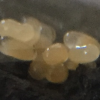- Formiculture.com
- Forums
- Gallery
- Members
- Member Map
- Chat

3 replies to this topic
#1
 Offline
-
Posted April 9 2018 - 7:03 AM
Offline
-
Posted April 9 2018 - 7:03 AM
Hello, I am new to the forum. Sorry if the question does not correspond to this section of the forum, but I have a problem with the Fluon. I kept my container in the refrigerator (as recommended where I bought it) and trying to keep the solution homogeneous (by careful movements to avoid generating bubbles). However, it took a while without being used. When I decided to use it again I noticed that a lot of liquid had evaporated and that half of the content had solidified.
My question is, can it be resuspended in some solvent or is it no longer useful?
regards
Nicolas
#2
 Offline
-
Posted April 9 2018 - 8:30 AM
Offline
-
Posted April 9 2018 - 8:30 AM
I believe it can be mixed with water and still retain it's slippery ability.
#3
 Offline
-
Posted April 9 2018 - 11:26 AM
Offline
-
Posted April 9 2018 - 11:26 AM
I read somewhere that if it settles and forms a layer that stuff is irreversible and can't be suspended again.
Keeping: Camponotus sansabeanus - C. vicinus - Formica francoeuri - Liometopum occidentale - Pogonomyrmex californicus - P. rugosus - P. subnitidus - Solenopsis molesta - S. xyloni - Tapinoma sessile - Temnothorax sp.
Journals: Camponotus sansabeanus & C. vicinus | Pogonomyrmex californicus & P. rugosus | Solenopsis molesta & S. xyloni
Discontinued: Pogonomyrmex subnitidus
#4
 Offline
-
Posted April 9 2018 - 1:52 PM
Offline
-
Posted April 9 2018 - 1:52 PM
Settling of diluted Fluon is reversible, but clumping from overagitation is not. Undiluted Fluon is far more difficult, if not impossible, to incorporate back into solution because the density is so high to begin with. If a significant amount of water has evaporated out of a bottle that was not kept airtight, it is better to discard, since the resulting product will likely be very scummy and full of microorganisms.
In any case, to incorporate Fluon back into solution, first ensure there is a sufficient amount of free water, and then gently turn the bottle (like turning a doorknob back and forth repeatedly), taking care not to shake the contents. Each movement will create a sort of ocean wave, which will scrape off a fine layer of Fluon particles back into the water. Depending on the density of compacted Fluon at the bottom of the container, the amount of free water, and other factors, it may take 30-60 minutes or more of constant turning until the Fluon has been reincorporated back into solution.
It may be possible to speed the process by scraping the Fluon off the bottom of the container so that it is free in the solution, as opposed to being stuck on the bottom. By doing this, you're increasing the surface area over which water may dissolve the Fluon particles at the surface of the clump back into solution. However, if the process is ended early, you may end up with chunks of free-floating Fluon.
- Shifty189 likes this
byFormica® is the manufacturer of the iconic nectar feeders and Sunburst Ant Nectar.
byFormica ant products always deliver consistent performance, convenience,
and reliability, making them among the most beloved ant foods and kit enjoyed by
ant keeping enthusiasts worldwide. For more information, visit www.byFormica.com.
Also tagged with one or more of these keywords: fluon
 |
Ant Keeping →
General Ant Keeping →
Best place to buy fluonStarted by AntsTx , Apr 18 2025 |
|

|
|
Ant Keeping →
General Ant Keeping →
I have joined the Talc barrier sideStarted by aznphenom , May 24 2022 |
|

|
||
Ant Keeping →
General Ant Keeping →
Budget FluonStarted by Dry_Twig , Sep 29 2020 |
|

|
||
Ant Keeping →
General Ant Keeping →
Fluon AlternativesStarted by Pumpkin_Loves_Ants , Sep 16 2019 |
|

|
||
Ant Keeping →
General Ant Keeping →
DIY Natural-looking Plaster OutworldStarted by jdsaunders1390 , Oct 8 2017 |
|

|
1 user(s) are reading this topic
0 members, 1 guests, 0 anonymous users

















